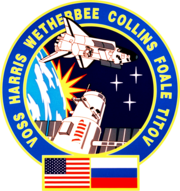STS-63
| STS-63 | |||||
 | |||||
| Uppdrag | 67 | ||||
|---|---|---|---|---|---|
| Rymdfärja | Discovery (20)[1] | ||||
| NSSDC-ID | 1995-004A[2] | ||||
| Färdens tid | 8 dagar, 6 timmar, 29 minuter, 36 sekunder | ||||
| Uppskjutning | |||||
| Startplats | Pad 39B vid Kennedy Space Center i Florida | ||||
| Start | 3 februari 1995, 05:22:04 UTC | ||||
| Landning | |||||
| Landningsplats | KSC runway 15 | ||||
| Landning | 11 februari 1995, 11:51:40 UTC | ||||
| Omloppsbana | |||||
| Varv | 129 st[3] | ||||
| Apogeum | 342 km | ||||
| Perigeum | 275 km | ||||
| Banlutning | 51,6° | ||||
| Sträcka | 2,992 miljoner km | ||||
| Rymdpromenad | |||||
| Antal | 1 st | ||||
| Total tid | 4 timmar, 39 minuter | ||||
| Besättning | |||||
| Befälhavare | James D. Wetherbee (3) | ||||
| Pilot | Eileen Collins (1) | ||||
| Uppdragsspecialister | Michael Foale, Ph.D. (3) Janice E. Voss, Ph.D. (2) Bernard A. Harris, Jr., M.D. (2) Vladimir Titov (4) Ryssland | ||||
 | |||||
| Kronologi Rymdfärjeprogrammet | |||||
| |||||
STS-63 var den 67 flygningen i det amerikanska rymdfärjeprogrammet och den tjugonde i ordningen för rymdfärjan Discovery. Den sköts upp från Pad 39B vid Kennedy Space Center i Florida den 3 februari 1995. Efter drygt åtta dagar i omloppsbana runt jorden återinträdde rymdfärjan i jordens atmosfär och landade vid Kennedy Space Center.
Resan gick till den ryska rymdstationen Mir för att förbereda den första dockningen, som skulle ske med STS-71. I rymdfärjans lastrum bar man även en Spacehab modul.
Eileen Collins blev genom flygningen rymdfärjeprogrammets första kvinnliga pilot.
Flygningens mål
Flygningens mål var att testa rymdfärjans förmåga att på ett kontrollerat sätt närma sig rymdstationen Mir. Som närmast befann man sig 11 meter från rymdstationen. Under flygningen började flera styrraketer läcka bränsle.
Se även
Referenser
- ^ NASA Space Shuttle Launch Archive Arkiverad 20 mars 2009 hämtat från the Wayback Machine., läst 28 juli 2016.
- ^ ”NASA Space Science Data Coordinated Archive” (på engelska). NASA. https://nssdc.gsfc.nasa.gov/nmc/spacecraft/display.action?id=1995-004A. Läst 20 mars 2020.
- ^ Manned Astronautics - Figures & Facts Arkiverad 4 mars 2016 hämtat från the Wayback Machine., läst 28 juli 2016.
Externa länkar
 Wikimedia Commons har media som rör STS-63.
Wikimedia Commons har media som rör STS-63.
| ||||||||
| |||||||||||||
| ||||||||||||||||||||||||||||||||
Media som används på denna webbplats
Författare/Upphovsman: Pascal (Flickr user: pasukaru76), Licens: CC0
Vostok spacecraft replica at the Technik Museum Speyer, Germany.
MIR Space Station Emblem
STS-66 Mission Insignia
STS-63 Mission Insignia
STS-67 Mission Insignia
STS-63 Crew
- Crew members assigned to the STS-63 mission included (front left to right) Janice E. Voss, mission specialist; Eileen M. Collins, pilot; (the first woman to pilot a Space Shuttle), James D. Wetherbee, commander; and Vladmir G. Titov (Cosmonaut). Standing in the rear are mission specialists Bernard A. Harris (the first Afro-American to walk in space), and C. Michael Foale. Launched aboard the Space Shuttle Discovery on February 3, 1995 at 12:22:04 am (EST), the primary payload for the mission was the SPACEHAB-3. STS-63 marked the first approach and fly around by the Shuttle with the Russian space station Mir.










